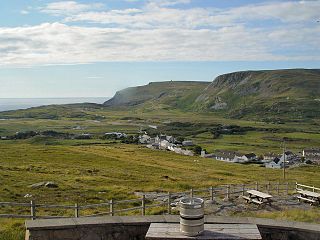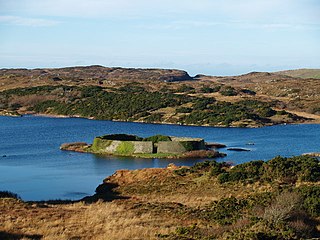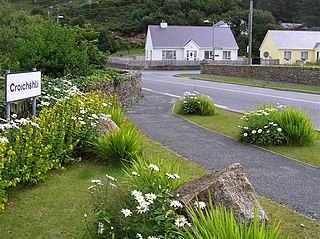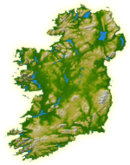Goll mac Morna was a member of the fianna and an uneasy ally of Fionn mac Cumhail in the Fenian Cycle of Irish mythology. He had killed Fionn's father, Cumhal, and taken over the leadership of the fianna, but when Fionn grew up and proved his worth Goll willingly stepped aside in his favour.
The Conlon family is an Irish noble family, the original Gaelic spelling being Ó Connalláin. In the tenth and eleventh centuries, the O'Conalláin were Princes of Ui Laeghari, an extensive territory in the counties of Meath and Westmeath, where the High King of Ireland historically derived his seat at the Hill of Tara. The O'Conlons were chiefs of Crioch Tullach, in County Tyrone and branches of this family in the twelfth and thirteenth centuries settled in the counties of Roscommon, Galway and Mayo. As a sept of the Northern Uí Néill, they claim descent from Niall of the Nine Hostages and his son Conall Gulban, both High Kings of Ireland.

Gleann Cholm Cille, anglicised as Glencolumbkille or Glencolmcille, is a small district on the Atlantic coast of southwest County Donegal in Ireland. Named after Saint Colm Cille (Columba), it is also a civil parish in the historic barony of Banagh. Glencolmcille is in the Gaeltacht, and while it remains an Irish-speaking community, English has been steadily replacing Irish as the main language, with only 34% of residents speaking Irish on a daily basis in 2002. The village of Cashel is the main settlement in the district.
Conall Gulban was an Irish king and eponymous ancestor of the Cenél Conaill, who founded the kingdom of Tír Chonaill in the 5th century, comprising much of what is now County Donegal in Ulster. He was the son of Niall Noígiallach.

Eógan mac Néill was a son of Niall Noígiallach and the eponymous ancestor of the Cenél nEógain branch of the Northern Uí Néill. The Cenél Eoghan would found the over-kingdom of Ailech and later Tír Eoghain, which would span the greater part of Ulster. His burial place is said to be in the Inishowen Peninsula in County Donegal, Ireland which was named after him. The historical accuracy or existence of Eógan and his father however are unknown.

The O'Doherty family of County Donegal is an Irish clan who were a prominent sept of the Northern Uí Néill's Cenél Conaill, and one of the most powerful clans of Tír Connaill.

Tyrconnell, also spelled Tirconnell and Tirconaill, was a kingdom of Gaelic Ireland. It is associated geographically with present-day County Donegal, which was officially named County Tirconaill between 1922 and 1927. At times it also included parts of County Fermanagh, County Sligo, County Leitrim, County Tyrone and County Londonderry at its greatest extent. The kingdom represented the core homeland of the Cenél Conaill people of the Northern Uí Néill and although they ruled, there were smaller groups of other Gaels in the area.

The Gallagher family of County Donegal, formerly one of the leading clans of Cenél Conaill, and therefore of all Ulster, originated in the 10th century as a derivative of their progenitor Gallchobhar mac Rorcain, senior-most descendant of Conall Gulban, son of Niall Mór Noigíallach. The O'Gallaghers held the High Kingship of Ireland during the early medieval period. They also held the rank of hereditary Marshal of the Kingdom of Tyrconnell, ruled by their kinsmen the O'Donnells, from the 14th until the early 17th century.

Downings or Downies is a Gaeltacht village and townland on the Rosguill peninsula in County Donegal, Ireland. The village is on the shores of Sheephaven Bay on the north coast of Ireland.

St Eunans GAA is a dual club which plays hurling and Gaelic football. Its home ground is O'Donnell Park in Letterkenny. It fields 35 teams, making it the biggest club in its county.

The O'Boyle family of County Donegal were a clan of the Northern Uí Néill, a great tribal dynasty of the North Gaels descended from Niall of the Nine Hostages. The O'Boyles were one of the principal families of the Cenél Conaill within the Northern Uí Néill and originally Chiefs of the Three Tuaths in the northwest of Tír Chonaill. When these lands passed to The MacSweeneys, the O'Boyle became chiefs of Tír Ainmhireach, later to be known as Críoch Bhaoigheallach, or O'Boyles country, now the Barony of Boylagh.

Portnablagh is a small village in County Donegal in Ulster, the northern province in Ireland. Portnablagh is located on the north-west coast of County Donegal, specifically the west side of Sheephaven Bay. It is on the N56 road.

Croithlí or Croichshlí is a village in the Gaeltacht parishes and traditional districts of Gweedore and The Rosses in the west of County Donegal in Ulster, the northern province in Ireland. The two 'districts' are separated by the Crolly River. It has one convenience shop/restaurant and petrol station and one public house, Páidí Óg's. Crolly is located in two baronies: the Gweedore part of the village is in the Barony of Kilmacrenan, while The Rosses part of the village is in the Barony of Boylagh, the Crolly River being the boundary between the two baronies.
McMenamin is an Irish surname. In Gaelic it is rendered, Mac Meanman, meaning 'son of Meanma' a name meaning courageous or high spirited. It originated in County Donegal in the 13th century. The first written mention of the name is in 1303 in the 'Annals of Loch Cé' which records the deaths of Donnchadh Mac Meanman and Aedh Mac Meanman, grandsons of the Lector O'Domnhaill, the chieftain of Fanad, during a dynastic struggle within the Cenél Conaill. The McMenamins are a branch of the O'Donnells of Tyrconnell (Donegal) and are part of the Sil Lugdach, descendants of Lugaid mac Sétnai, the great-grandson of Conall Gulban. Like many discarded branches of noble families, the McMenamins sought advancement in the church evidenced by numerous mentions of McMenamin prelates in papal letters from the late 1300s to the late 1400s. They were supplanted in their home territory of Fanad by the Sweeneys and over the centuries became more distantly related to the royal line of the Cenél Conaill. One scholar describes the family as "...a discarded branch of the O'Donnell dynasty"
Gaeltacht an Láir is an Irish-speaking area in the central part of County Donegal in the west of Ulster, the northern province in Ireland. It centres on the village of Baile na Finne (Fintown) and stretches south to Gleann Colm Cille and north to Fanad and Rosguill. There are nearly 7,000 people living in the area and 2,000 daily Irish speakers.

Cairbre Drom Cliabh was an Irish túath in the ancient confederation of Íochtar Connacht, now County Sligo in the west of Ireland. It is now represented by the barony of Carbury. Also known as Cairbre na Catha. It existed from at least the 6th century to the 16th century AD.

The Northern Uí Néill was any of several dynasties in north-western medieval Ireland that claimed descent from a common ancestor, Niall of the Nine Hostages. Other dynasties in central and eastern Ireland who also claimed descent from Niall are termed the Southern Uí Néill. The dynasties of the Northern Uí Néill were the Cenél Conaill and Cenél nEógain, named after the two most powerful sons of Niall: Conall and Eógain.
The Cenél Conaill, or "kindred of Conall", are a branch of the Northern Uí Néill, who claim descent from Conall Gulban, son of Niall of the Nine Hostages, and allegedly the first Irish nobleman to convert to Christianity. Their kingdom was known as Tír Conaill, with their powerbase at Mag Ithe in the Finn valley, however they gradually expanded to cover what is now counties Donegal and Fermanagh. The Cenél Conaill clashed regularly with their kin the Cenél nEogain, eventually capturing the latter's original power-base of Ailech in the Inishowen peninsula—in modern-day County Donegal—by the 12th century.

Tullygallan is a townland in the civil parish of Drumhome, Roman Catholic parish of Drumholm, barony of Tirhugh, County Donegal, Ireland.















